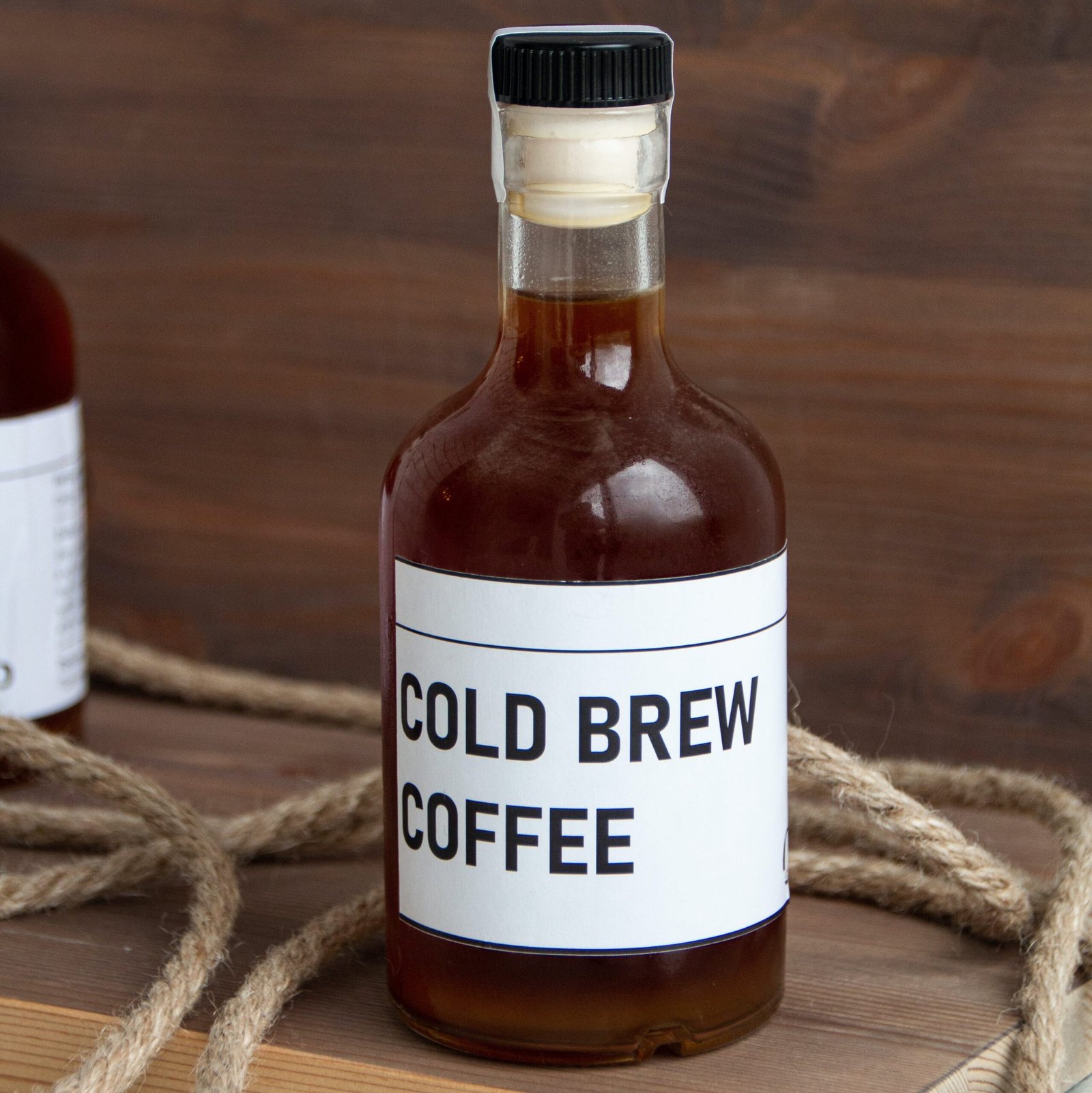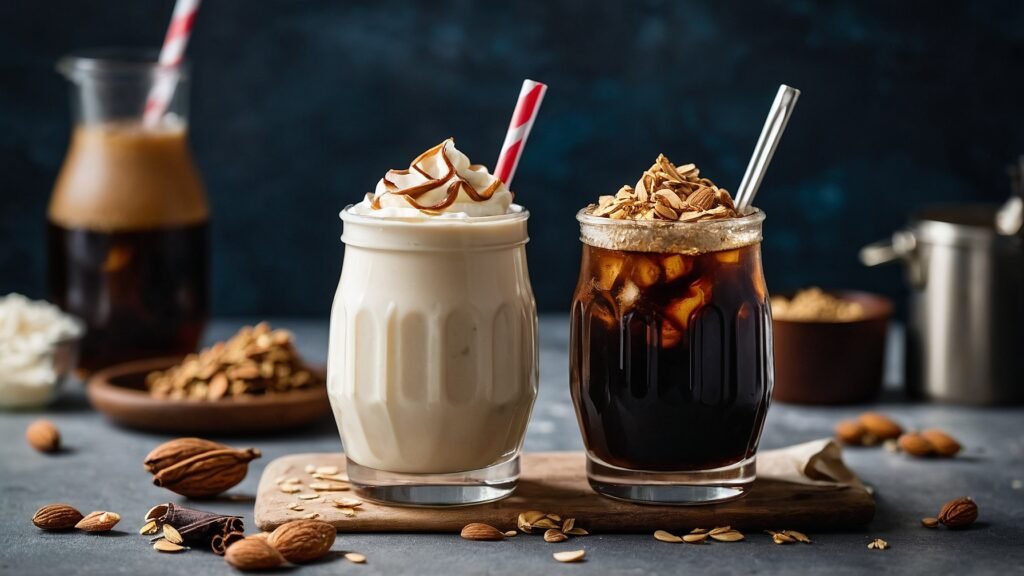Introduction to Cold Brew Iced Coffee

Cold brew iced coffee is an exquisite beverage with a unique brewing process that relies on time rather than heat to extract the coffee’s oils, sugars, and caffeine.
This procedure results in a smooth, low-acidity beverage with a naturally sweet flavor profile that is free from the bitterness often associated with traditional hot-brew methods. Cold brew iced coffee is more than a refreshing, caffeinated drink—it’s a testament to patience and craftsmanship.
In recent years, cold brew has become a popular choice among coffee connoisseurs, and its popularity is only growing. The nuanced flavors and the complexity of the brew have been enthralling coffee lovers around the globe.
What was once a niche option, offering a distinct departure from traditional iced coffee, has now become a mainstream phenomenon.
Understanding the Cold Brew Process
The cold brew process is a methodical yet straightforward practice. It involves steeping coffee grounds in room temperature or cold water for an extended period, typically between 12 to 24 hours. This slow extraction allows the coffee to retain its natural flavors, creating a rich, smooth beverage with a notable lack of bitterness.
Although simple in concept, the cold brew process requires careful attention to details. Variables such as the grind size, steeping time, and water-to-coffee ratio can significantly impact the final product’s taste. Mastering these variables paves the path to producing a consistently delicious cold brew.
Benefits of Making Cold Brew Iced Coffee at Home
Creating homemade cold brew iced coffee imparts several advantages, not least of which is the unparalleled freshness it offers. When you brew your own coffee, you control every aspect of the process, allowing for an optimized flavor profile tailored to your preferences. Furthermore, it provides an opportunity to experiment with different beans and brewing times, facilitating a personalized and fulfilling coffee experience.
Moreover, making cold brew at home can be cost-effective. Instead of spending on overpriced coffee at cafes, investing in home-brewing equipment can yield long-term savings. Additionally, the convenience of having a quality cold brew readily available at home simplifies your daily routine, reducing the need for coffee shop visits.
Necessary Equipment for Home Cold Brew

The mandatory apparatus for home cold brewing is surprisingly minimal. A large container or jar, coarse-ground coffee, and a strainer or cheesecloth are the fundamental requisites.
For a more nuanced and controlled brewing process, a dedicated cold brew coffee maker—equipped with a built-in filter and measurement markers—can be an invaluable asset.
Additionally, a quality coffee grinder is a wise investment for those committed to the art of cold brewing.
The ability to grind your own beans ensures optimal freshness. While pre-ground coffee can suffice, freshly ground beans will always yield a superior brew.
Selecting the Perfect Coffee Beans
The choice of coffee beans plays a pivotal role in the final taste of your cold brew. Medium to dark roast beans are generally recommended as they yield a robust, full-bodied brew. However, the beauty of home brewing lies in the freedom to experiment. Don’t be afraid to try different varieties; each bean has its own unique flavor profile that is accentuated by the cold brewing process.
It’s essential to use high-quality, freshly roasted beans for the best results. While supermarket brands may suffice, investing in beans from a reputable roaster or coffee shop can elevate your cold brew to new heights. Always remember that the quality of your brew is directly proportional to the quality of your beans.
Preparing Your Coffee Beans for Brewing
Once you’ve selected your beans, proper preparation is essential to harness their full potential. For cold brew, a coarse grind is typically recommended. This promotes even water flow around the grounds and slow, steady extraction, which is key to achieving the smooth taste characteristic of cold brew.
Grinding your beans immediately before brewing ensures optimal freshness. The longer the grounds sit after being brewed, the more flavor they lose. It’s also worth noting that the water-to-coffee ratio significantly impacts the taste, with a higher ratio resulting in a stronger brew.
Step-by-Step Guide to Brewing Cold Brew Coffee at Home

1. Initiating the cold brew process begins with combining your coarsely ground coffee beans with room temperature or cold water. Generally, a ratio of 1:4 (coffee to water) is recommended, but this can be adjusted to personal preference.
2. Stir the mixture gently to ensure all the grounds are wet, then cover and leave it undisturbed for 12-24 hours.
3. After the steeping period, the brew needs to be strained to separate the liquid from the coffee grounds. Using a cheesecloth or fine mesh sieve, gently pour the mixture, ensuring no grounds make it into the final brew.
4. The resulting liquid is a concentrated cold brew which can be diluted with water or milk to taste, or stored in a refrigerator for up to two weeks.
Essential Tips for Perfect Cold Brew Coffee
Achieving the perfect cold brew requires a blend of science and art. Using filtered water can prevent unwanted flavors from interfering with the taste of the brew. Additionally, stirring the brew occasionally during the steeping period can promote even extraction.
Another crucial aspect is patience. Rushing the process can result in an under-extracted brew, lacking in complexity and depth. The longer the steeping period, the more flavor compounds are drawn out of the beans. By allowing ample time for extraction, you’re rewarded with a richer, smoother brew.
Troubleshooting Common Cold Brew Problems
Despite its simplicity, the cold brew process can sometimes present challenges. If your brew tastes weak or watery, it’s likely due to an insufficient steeping time or a water-to-coffee ratio that’s too high. Conversely, an over-steeped brew or an overly concentrated mixture can result in a bitter, unpleasant taste.
Cloudiness is another common issue, often caused by grinding the coffee too finely or not filtering the brew properly. By adjusting your grind size and ensuring thorough filtration, you can achieve a clear, clean brew.
Creative Ways to Serve and Customize Your Cold Brew

Cold brew coffee is versatile and can be tailored to your personal taste. For a simple twist, try adding a few drops of vanilla extract or a sprinkle of cinnamon to your brew. For a creamier version, experiment with different types of milk or cream. Almond, oat, and soy milk all offer unique flavor profiles that can complement the coffee.
For an indulgent treat, you can transform your cold brew into a dessert by adding a scoop of vanilla ice cream for an affogato-style drink. Or, blend it with ice for a refreshing coffee slushie. The possibilities are endless, and the beauty of homemade cold brew is the freedom to get creative.
Maintaining Your Cold Brew Equipment
Proper maintenance of your cold brew equipment is essential to ensure consistently high-quality brews. After each use, rinse your brewing vessel and filter thoroughly to remove any residual coffee grounds. For a deep clean, consider using a coffee equipment cleaner or a mix of vinegar and water to remove any build-up or oil residue.
Maintaining your grinder is also crucial. Over time, coffee grounds can accumulate and become compacted, reducing the grinder’s effectiveness. Regular cleaning can keep your grinder in optimal condition, ensuring consistently coarse grounds ideal for cold brewing.
Conclusion: The Joys of Homemade Cold Brew Coffee
Embarking on the journey of making your own cold brew iced coffee at home can be a rewarding experience. It provides an intimate understanding of the coffee brewing process and the satisfaction of creating a beverage tailored to your taste. The process is straightforward, yet allows room for experimentation and creativity.
The joy of homemade cold brew extends beyond the delicious beverage itself. It’s about the process, the anticipation, and the satisfaction of savoring a coffee that you’ve crafted yourself. So grab your coffee beans and brewing equipment, and embark on the delightful journey of homemade cold brew coffee.
